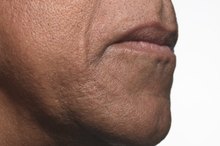What does fact checked mean?
At Healthfully, we strive to deliver objective content that is accurate and up-to-date. Our team periodically reviews articles in order to ensure content quality. The sources cited below consist of evidence from peer-reviewed journals, prominent medical organizations, academic associations, and government data.
The information contained on this site is for informational purposes only, and should not be used as a substitute for the advice of a professional health care provider. Please check with the appropriate physician regarding health questions and concerns. Although we strive to deliver accurate and up-to-date information, no guarantee to that effect is made.
Potential Causes of a Dark Upper Lip
A dark upper lip can be cause for embarrassment and concern. If you previously had smooth, even skin tone, seeing a darkening of the skin above your lip will likely seem obvious when you look in the mirror. Before you panic or cover it up with makeup, see your doctor or dermatologist, who can deduce whether it's caused by a medical condition.
Hirsutism
What looks like a darkening of your upper lip may actually be a darkening of the hair above your upper lip. Hirsutism, the clinical name for excess hair growth on the body, affects mainly women and is evidenced by dark, coarse hair, especially on the face, notes the American Academy of Family Physicians. It may also be accompanied by a deeper voice, irregular periods, acne and decreased bust size. Your health care provider will likely want to examine the hair and possibly diagnose the problem as polycystic ovarian syndrome or another illness that causes hirsutism and, subsequently, the darkening of your upper lip.
- What looks like a darkening of your upper lip may actually be a darkening of the hair above your upper lip.
- Your health care provider will likely want to examine the hair and possibly diagnose the problem as polycystic ovarian syndrome or another illness that causes hirsutism and, subsequently, the darkening of your upper lip.
Melasma
How to Get Rid of Dark Shadow Above My Lip
Learn More
Melasma, also known as "pregnancy mask," usually occurs when a woman is pregnant or taking birth control pills. The excess hormones in the body can often cause a darkening of the skin around the nose and mouth, known as macular hyperpigmentation, according to the American Academy of Dermatology. Melasma is aggravated by sun exposure, so if you notice your upper lip is darkening, stay out of the sun or apply sunscreen each time you go outside. Most often, melasma goes away on its own after pregnancy or the end of birth control pills, but facial bleaching can also be an effective way to stop it. Always check with your doctor, though, for the final word.
- Melasma, also known as "pregnancy mask," usually occurs when a woman is pregnant or taking birth control pills.
- Most often, melasma goes away on its own after pregnancy or the end of birth control pills, but facial bleaching can also be an effective way to stop it.
Sun Damage
Being out in the sun with little or no protection can result in a darkening of the upper lip through sun damage and sun spots, warns the American Cancer Society 2. In fact, sun damage as exhibited through brown sun spots around the face can be an early warning sign of a predisposition to skin cancer. If you already have sun spots, are prone to sunburn or sun damage, or spend a lot of time outdoors, always apply a sunscreen before you go outside. If regular sunscreen seems too greasy for your face, try an oil-free version and wear a hat to shade your face for fairer, more even skin. Again, always consult your doctor for a definitive diagnosis.
- Being out in the sun with little or no protection can result in a darkening of the upper lip through sun damage and sun spots, warns the American Cancer Society 2.
- If regular sunscreen seems too greasy for your face, try an oil-free version and wear a hat to shade your face for fairer, more even skin.
Related Articles
References
- FamilyDoctor.org: Hirsutism
- American Cancer Society: Skin Cancer Prevention and Early Detection
- Achar A, Rathi SK. Melasma: a clinico-epidemiological study of 312 cases. Indian J Dermatol. 2011;56(4):380-382. doi:10.4103/0019-5154.84722
- Handel AC, Miot LDB, Miot HA. Melasma: a clinical and epidemiological review. An Bras Dermatol. 2014;89(5):771-782. doi:10.1590/abd1806-4841.20143063
- Plensdorf S, Martinez J. Common pigmentation disorders. Am Fam Physician. 2009;79(2):109-116.
- Cestari TF, Dantas LP, Boza JC. Acquired hyperpigmentations. An Bras Dermatol. 2014;89(1):11-25. doi:10.1590/abd1806-4841.20142353
- Yamaguchi Y, Hearing VJ. Melanocytes and their diseases. Cold Spring Harb Perspect Med. 2014;4(5). doi:10.1101/cshperspect.a017046
- Ogbechie-Godec OA, Elbuluk N. Melasma: an Up-to-Date Comprehensive Review. Dermatol Ther. 2017;7(3):305-318. doi:10.1007/s13555-017-0194-1
- Basit H, Godse KV, Al Aboud AM. Melasma. In: StatPearls. Treasure Island, FL: StatPearls Publishing; 2019.
- Pichardo R, Vallejos Q, Feldman SR, et al. The prevalence of melasma and its association with quality of life in adult male Latino migrant workers. Int J Dermatol. 2009;48(1):22-26. doi:10.1111/j.1365-4632.2009.03778.x
- Sarkar R, Ailawadi P, Garg S. Melasma in Men: A Review of Clinical, Etiological, and Management Issues. J Clin Aesthet Dermatol. 2018;11(2):53-59.
- Passeron T, Picardo M. Melasma, a photoaging disorder. Pigment Cell Melanoma Res. 2018;31(4):461-465. doi:10.1111/pcmr.12684
- Rivas S, Pandya AG. Treatment of melasma with topical agents, peels and lasers: an evidence-based review. Am J Clin Dermatol. 2013;14(5):359-376. doi:10.1007/s40257-013-0038-4
- Jadotte YT, Schwartz RA. Melasma: insights and perspectives. Acta Dermatovenerol Croat. 2010;18(2):124-129.
- Vashi NA, Kundu RV. Facial hyperpigmentation: causes and treatment. Br J Dermatol. 2013;169 Suppl 3:41-56. doi:10.1111/bjd.12536
- Hasegawa K, Fujiwara R, Sato K, et al. Possible Involvement of Keratinocyte Growth Factor in the Persistence of Hyperpigmentation in both Human Facial Solar Lentigines and Melasma. Ann Dermatol. 2015;27(5):626-629. doi:10.5021/ad.2015.27.5.626
- Plensdorf S, Livieratos M, Dada N. Pigmentation Disorders: Diagnosis and Management. Am Fam Physician. 2017;96(12):797-804.
- Shankar K, Godse K, Aurangabadkar S, et al. Evidence-based treatment for melasma: expert opinion and a review. Dermatol Ther. 2014;4(2):165-186. doi:10.1007/s13555-014-0064-z
- Grimes PE, Ijaz S, Nashawati R, Kwak D. New oral and topical approaches for the treatment of melasma. Int J Womens Dermatol. 2019;5(1):30-36. doi:10.1016/j.ijwd.2018.09.004
- Handa S, De D, Khullar G, Radotra BD, Sachdeva N. The clinicoaetiological, hormonal and histopathological characteristics of melasma in men. Clin Exp Dermatol. 2018;43(1):36-41. doi:10.1111/ced.13234
- Lee A-Y. Recent progress in melasma pathogenesis. Pigment Cell Melanoma Res. 2015;28(6):648-660. doi:10.1111/pcmr.12404
Writer Bio
Kay Ireland specializes in health, fitness and lifestyle topics. She is a support worker in the neonatal intensive care and antepartum units of her local hospital and recently became a certified group fitness instructor.









